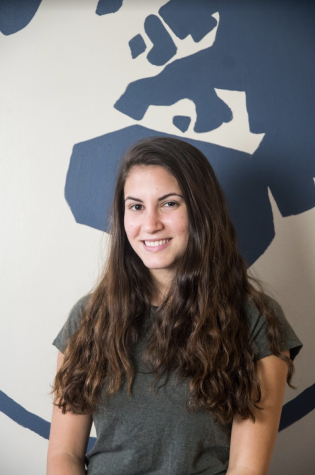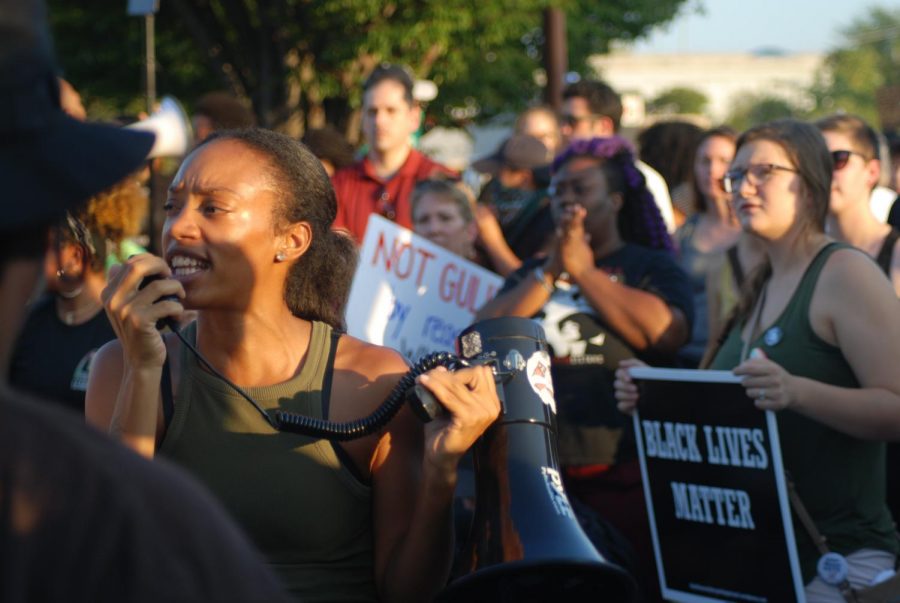“Two police officers came out and told us to get down on the ground. We got down on the ground, they were angry, they were mean, they zip tied us, and put us in separate cars,” CHS Senior Lizzy Mills said.
Officers arrested Lizzy Mills and fellow Senior Josh Hagene on September 17, while participating in a Stockley protest for the Black Lives Matter movement.
The protest, outside of the police headquarters, lasted from 3:00 p.m to 7:00. “We gathered in a tight mass in front of the headquarters, chanting. Crowds of police officers were gathering within the building. Some didn’t know how to react, some were filming us, some were laughing,” Mills explained.
As the crowd grew restless, they began to march. “As we were walking through the streets, a few people decided to push over the pots and break things. The cops at that point were starting to surround us but we couldn’t see them yet,” Hagene said.
Mills explained, “Everyone around us just ran. Josh and I kept running and made it to the driveway of the Holiday Inn, and then this Dodge pulled up.”
Hagene and Mills were arrested and charged with destruction of property.
“My arresting officer said that he saw me throw something in a window. What bothers me most about this is how confident he was,” Mills said, “I don’t think I’m even strong enough to throw something in a window to break it.”
At the Justice Center, however, their charges were reduced to “failure to disperse”.
Mills recently became involved in the movement when the Stockley verdict was released. “I’ve been aware of [the movement] and have been keeping tabs on it but it wasn’t until the Stockley verdict that I personally became involved and felt the need to go down there and protest,” she said.
Hagene became involved in the movement after his Cultural Leadership transformation journey. “Cultural leadership taught me to take advantage of opportunities and actually fight for something I really believe in,” he said.
Their recent experiences and arrests have strengthened their passions and shaped their perspectives on the movement.
“I was definitely treated a lot better because I was white. [I got] a complete new perspective on my priviledge. Josh and I both have white parents who can easily afford to pay bail. Also my mom is a lawyer so she has a functioning knowledge of how the justice system works,” Mills said, comparing herself to the individuals she met in jail. “There were people who were arrested who can’t afford a lawyer or don’t have family members in St. Louis to bail them out. Also while you’re in there no one tells you what you’re charged for or what the process is of you leaving.”
Protesting is one of the primary ways in which the movement brings attention to racial inequality. Clarissa Hayward, political science professor at Washington University, explained the importance of protesting in politics. “It puts the issue on the political agenda and tells the democratic candidates in elections to address it,” Hayward said, “Public opinion and awareness have changed dramatically [since 2014], pretty clearly as a result of the protests.”
Protesting also causes individuals within communities to become more aware of the racial injustices pervading America.
“Look at how many more people wanted to get more informed on the matter because they saw people protesting,” Mills said, “There are so many other people who have been killed by cops and have had similar verdicts, but because Stockley’s verdict caused so many people to go out and demonstrate, tons of people want to become informed on the matter and want to talk about it.”
Although the movement and the issues it touches are not unique to St. Louis, the extreme segregation in St. Louis exacerbates the racial inequity. One of the goals of the movement, especially here in St. Louis, is to create a safe environment for the black community.
In the political world, the Black Lives Matter movement has changed the agendas and campaigns of Democratic and Republican parties.
“If you think about Clinton and Sanders and look at their campaigns when they were starting out, they didn’t really address [racial] issues one way or the other,” Hayward said.
Conventionally, in a two party system, politicians don’t tend to address controversial issues. They speak in vague terms and avoid addressing anything that might be divisive because they try to get as many votes as possible.
“But over time, both Clinton and Sanders started to adopt criminal justice and social justice platforms,” Hayward said. “The Black Lives Matter movement compels [politicians] to take a stance.”
As for Republican politicians, they have brought attention to the matters of the movement as well. Historically known as the Southern Strategy, this electoral strategy has been used by candidates such as Richard Nixon to gain political support. “[Republican politicians] get white people who are natural constituents of the Democratic party over to the Republican side by tapping into racial animosities,” Hayward explained.
Consequently, the recent election of Donald Trump has sparked more protests on the Black Lives Matter side.
“It is emboldened by members of Trump’s space to say things and behave in ways that are explicitly racist, ways which have been off the table for decades prior to Trump,” Hayward said.
The election of Trump has caused many people to openly express views regarding racial resistance. “I think the current administration took us a few steps back and now we’re forced to fight even harder to work for equality,” Hagene said.
In addition to protesting, Black Lives Matter also focuses on policy, as well as electoral politics.
“If you type into Google ‘Movement for Black Lives’, you will see a very detailed and thoughtful policy platform that they’ve developed. They’re trying to make change at a level of policy, and some of the protesters have won local offices in St. Louis,” Hayward said.
While police brutality has been the main focal point of the movement, Black Lives Matter also revolves around educational inequalities, health care and all the ways systemic racial inequality persists in the U.S.
“The Black Lives Matter movement is democracy,” Mills said. “This is the system that we’re supposed to be living in – where the people have a voice, and that voice matters and that voice can change things.”
Over the years, the movement has become more structured and efficient. There are clear leaders and organizers who come up with schedules and ideas to organize peaceful protests.
Compared to the raw protests in Ferguson, today’s protests are more organized and planned.
“Ferguson was the spark that set a whole fire blazing,” Mills said. “Michael Brown’s [case] pushed St. Louis to reach that boiling point where the black community just couldn’t sit by any longer. And I think since then, that awareness has reached the white communities and people like myself.”
The Black Lives Matter movement continues to push for change at the local and federal levels. “We need more people to go out to the protests and raise awareness and not get tired of it. We just need to keep going until things change,” Hagene said.

